If you want a green lawn throughout the winter, you should consider cool-season grasses and overseeding your summer lawn. The best winter grasses are Kentucky bluegrass, Rough bluegrass, Chewings fescue, Creeping red fescue, Sheep fescue, Tall fescue, Perennial ryegrass, and Annual ryegrass.
Are you under the impression that there is no lawn work during the winter season? If so, you are wrong. If you want a beautiful lawn in spring, winter might be ideal for planting grass seed.
Besides, depending on where you live, with proper wintertime lawn care, you might stand a chance of sustaining turf grass year-round. Do not get me wrong, though – there is no chance you can keep your warm-season grass green year-round. If you want non-stop color, you must plant winter grass seed over your “old” lawn.
Stay tuned to learn two things:
- How to start a lawn via dormant seeding?
- How to overseed your summer lawn with a cold-tolerant variety?
Contents
Comparison Of The Best Winter Grass Seed You Can Buy
| Optimum temps for seed germination (°F) | Cold Tolerance | Heat Tolerance | Drought Tolerance | Traffic Tolerance | |
| Kentucky Bluegrass | 59 – 86 | High | Moderate | Moderate | High |
| Rough Bluegrass | 68 – 86 | High | Low | Low | Low |
| Chewings Fescue | 69 – 77 | High | Moderate | Moderate-high | Low |
| Creeping Red Fescue | 59 – 77 | High | Moderate | Moderate | Moderate-low |
| Sheep Fescue | 59 – 77 | High | Moderate | Moderate-high | Moderate |
| Tall Fescue | 68 – 86 | Moderate-high | Moderate-high | High | Moderate-high |
| Perennial Ryegrass | 68 – 86 | Moderate-high | Moderate | Moderate-low | Moderate-high |
| Annual Ryegrass | 68 – 86 | Moderate | Low | Low | Moderate-low |
8 Types Of Winter Grass Seed
Michelle Ullman from Spruce magazine states that a green and healthy lawn starts with the right choice of grass seed for your climate. And I agree with her 100%. Many properties in my neighborhood have discolored grass simply because their owners don’t do their homework and make sure they are planting the right grass seeds for North Carolina’s humid subtropical climate.
Peter Landschoot, professor of turfgrass science at Penn State University, explains that there are two main types of grasses:
- Cool-season grasses that thrive in the northern U.S.
- Warm-season grasses that are best adapted to southern areas of the U.S.
If you want to plant grass seeds that can handle the winter temps, or you want a chance to enjoy a green lawn year-round, Professor Landschoot proposes the following cool-season grasses:
Kentucky Bluegrass
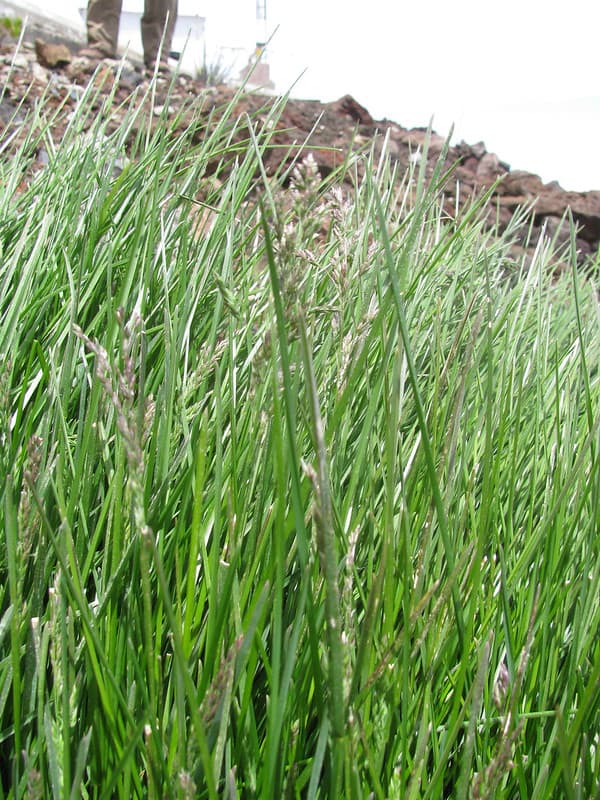
I think Kentucky bluegrass is one of the best-looking cool-season grasses due to its deep green, almost bluish color. If you plant it, your lawn will be soft and squishy – ideal for running over it barefoot. Don’t ask me how I know this! The photo above is courtesy of Forest and Kim Starr.
Marvin H. Hall, associate professor of agronomy at Penn State University, explains that Kentucky bluegrass is quite common in the northeastern United States because it tolerates close and frequent cutting better than other cool-season grasses.
In the words of Professor Hall, this grass can be “frost seeded” into existing lawns to thicken the stand. He advises securing good seed-to-soil contact by seeding a lawn that has a thin layer of existing grass. In short, you should complete frost-seeding Kentucky bluegrass while the soil contains frost, preferably early in the morning.
Rough Bluegrass

Experts from the Division of Agriculture and Natural Resources at the University of California explain that Rough bluegrass is a cool-season grass that best adapts to wet, cool, and shady areas, which means you can even use it for shaded turf in the fog belt areas. They say it is ideal for over-seeding dormant bermudagrass, too. The photo above is courtesy of Erin Murphy.
I am not a great fan of its yellow-green color and slightly tapered look, but I heard Rough bluegrass is one of the best shade grasses you can buy. Craig Edminster, the director of
Research at International Seeds, Inc., thinks Rough bluegrass might be the perfect choice for wintertime overseeding, especially in areas where this is a yearly practice.
Chewings Fescue

As explained by scientists from the University of Maryland Center for Environmental Science, Chewings fescue is a perennial cool-season grass native to Europe. It is often used for overseeding Bermuda grass or Buffalo grass lawns to maintain adequate winter color and cover. Chewings fescue is also commonly used in seed mixes with Kentucky bluegrass for sun or partial-shade lawns. I have also seen a mixture of Perennial ryegrass and Chewings fescue.
If you are looking for a cool-season grass that can tolerate extreme cold temperatures, Chewing fescue is not a number one choice. It has an excellent survival rate up to -10°C or 14° F (75-90%), but if temperatures drop any further, it will probably die off.
Creeping Red Fescue
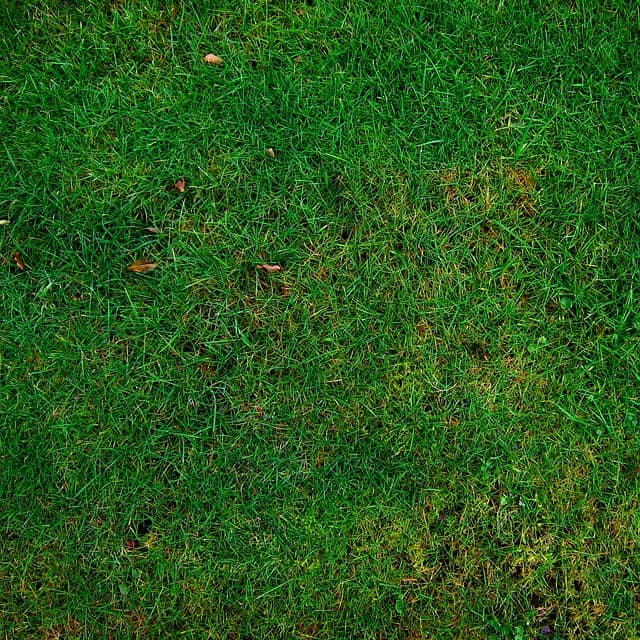
Creeping red fescue is another member of the “fine-leaved” fescues. An article I read on the Government of Alberta website describes Creeping red fescue as shade-tolerant, hardy, low-growing, and creeping-rooted cool-season grass that does well on varying soil types. This fine fescue is usually sold as a turf mixture in combination with US-grown perennial ryegrass and Kentucky bluegrass, or tall fescue and annual ryegrass.
The experts from the Mckays Grass Seed company describe Creeping red fescue as a lovely, soft, dark green grass. They say it is an ideal choice for a low-maintenance ground cover since it grows quickly, even in sandy soil.
I particularly like the fact that this grass is one of the most eco-friendly lawn grasses you can find on the market since it has pretty low water, mowing, and fertilization needs. Unfortunately, it is unsuitable for warmer regions or lawns subjected to heavy traffic from kids or pets.
Sheep Fescue

According to the U.S. Department of Agriculture, Sheep fescue is an extremely variable, densely tufted cool-season perennial grass native to Europe. This fine fescue has been introduced to many locations in North America, too. The photo above is courtesy of Programator2.
Should you consider Sheep fescue for your lawn? If you are looking for grass that has excellent cold tolerance and a decent shade and drought tolerance, this turf grass might be what you are looking for. It is the best choice for areas with more than 12 inches of precipitation, too.
I had a chance to see Sheep fescue in action when visiting my relatives in North Dakota. As I found out from them, this is a popular lawn grass in their neighborhood. It starts getting green in March and matures in late June or early July. During the summer season, growth is minimal. Hence, experts from the University of Maryland Center for Environmental Science advise that Sheep fescue should not be mowed between early June and early October.
Tall Fescue
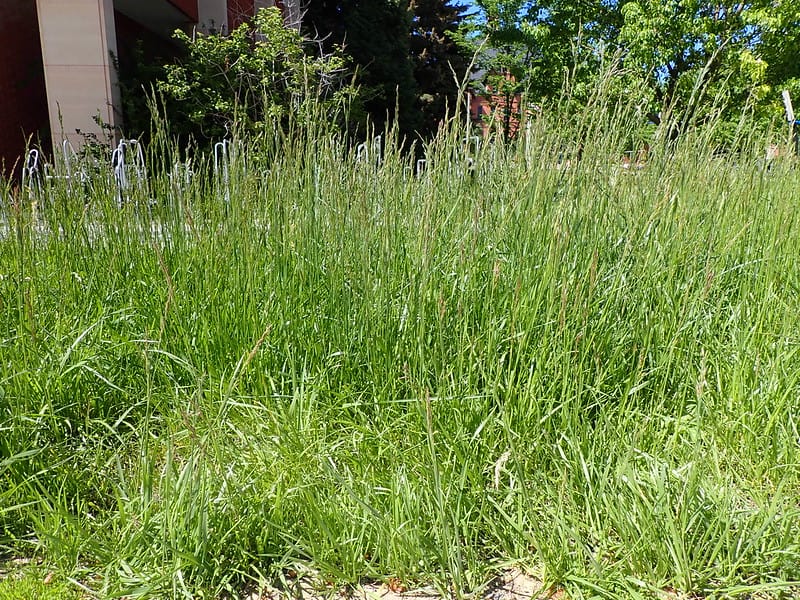
Thomas Cook, an emeritus turfgrass specialist at OSU Horticulture Department, says Tall fescue is probably the most widely planted cool-season lawn grass seed in the world. In his words, this perennial grass adapts to different climate areas. Besides, Tall fescue has one great advantage – it presumably produces the least thatch of all the cool-season lawn grasses. The photo above is courtesy of Matt Lavin.
What makes Tall fescue seed one of the best winter grass seeds? Its ability to survive all but the most severe winters. As Cook explains, Tall fescue is a bit more cold-tolerant than perennial ryegrass. Experts from the University of California’s Agriculture and Natural Resources explain that Tall fescue adapts well to sunny and partially shady areas, too.
I have had a Tall fescue lawn in the past, and I can say that it was a bit coarse-textured but had excellent weed and disease resistance. It tolerated the warm summer temperatures pretty well and stayed green during the winter. I prefer the color and softness of Kentucky bluegrass, but that does not mean I will not give Tall Fescue another chance in the future.
Perennial Ryegrass

Dr. Fred Yelverton, an extension specialist at the North Carolina State University, explains that Perennial ryegrass is a bunch-type grass typically used for winter overseeding on lawns that lack winter color. It is very similar to Kentucky bluegrass regarding its color and texture, so people often confuse the two. To learn how to tell the difference between them, check out the video below:
I often use Kentucky bluegrass and Perennial ryegrass mix for overseeding my lawn in winter. Even though these lawn grasses haven’t got a big chance to survive the hot Raleigh summers when we have a particularly wet or colder summer, Perennial ryegrass prevails. This is not necessarily a good thing though, because it can become clumpy and quite difficult to control.
Still, Kelly Burke, a professional turf manager accredited in organic land care, thinks that Perennial ryegrass has more pluses than minuses since it is low maintenance, fast-growing, and pest and disease-resistant. It is also a good companion for other grass species and grass seed mixes. She recommends choosing this grass for a permanent lawn if you live in cooler northern climates, or as a winter grass in southern climates where warm-season grass goes dormant.
Annual Ryegrass
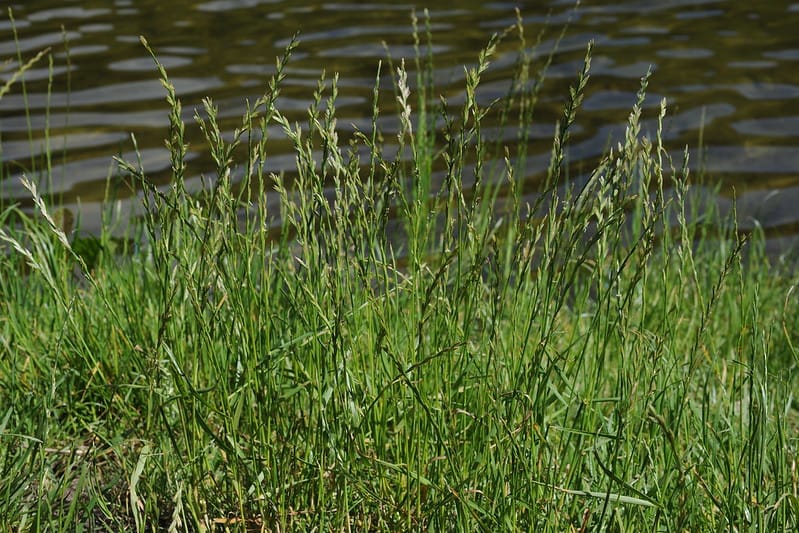
The aforementioned Dr. Yelverton from the North Carolina State University explains that Annual ryegrass or Italian ryegrass, is a bunch-type grass often used for quick cover or for winter overseeding of bermudagrass. It is of lower quality and is thus usually found in lower-budget, inferior seed blends that are not an ideal choice for sites where high-quality turf is desired. The photo above is courtesy of Joost J. Bakker IJmuiden.
That is why you should do what I always recommend – read the label to make sure you know what you are buying! If you want an inexpensive solution to add some winter color to your summer lawn, you can opt for the Annual ryegrass mixture, but if you are looking for quality, and want a lawn that can last longer than one season, opt for Perennial ryegrass mix instead.
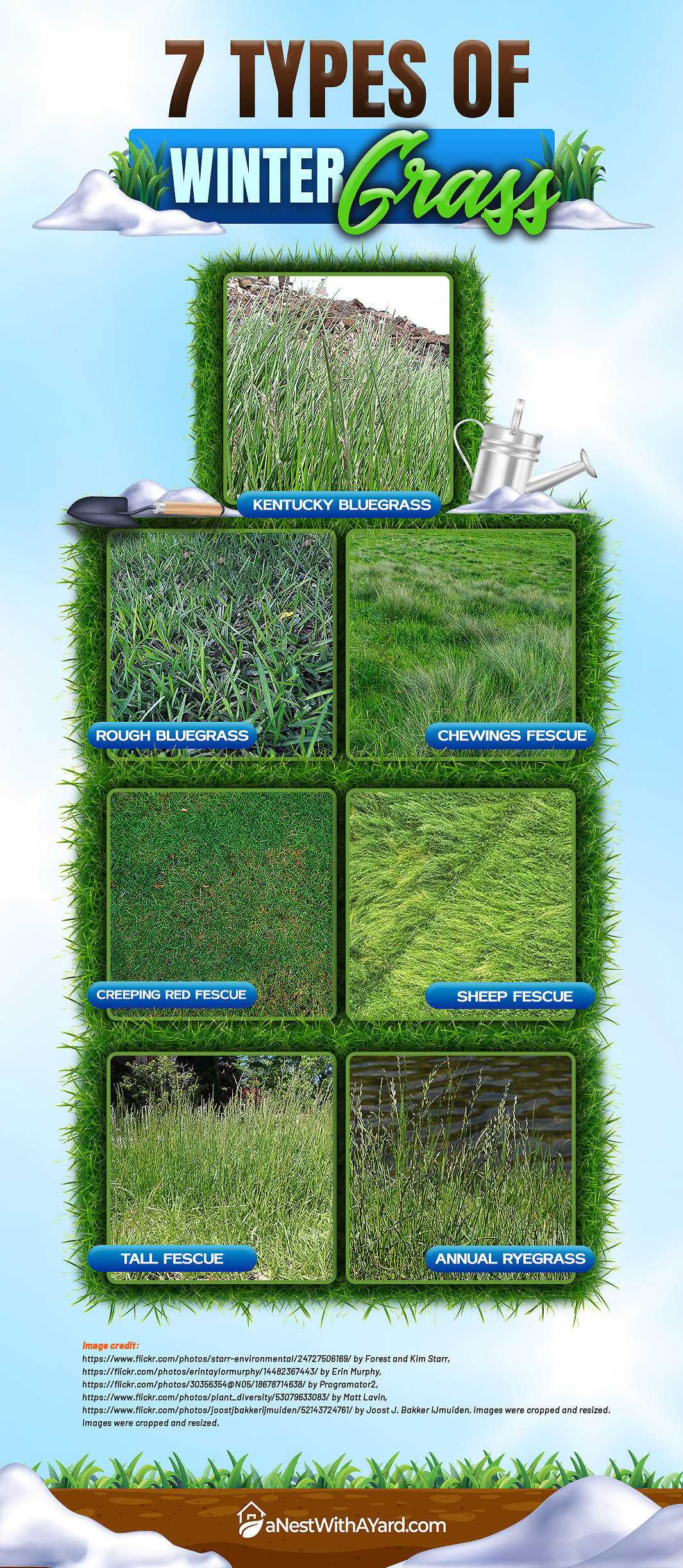
The 7 Best Winter Grass Care Tips & Tricks

In my opinion, combining cool-season grasses with warm-season grasses gives you the best chance to enjoy a green lawn year-round. Professionals from Mckays Grass Seeds Company agree and say there are a range of options for both cool season and warm season grasses you can choose from. If you cannot do it on your own, they recommend consulting with a lawn care specialist who can recommend the best winter lawn seed for your conditions.
Lawn maintenance experts from the reputable All American Turf Beauty company have some handy winter lawn care tips we should all follow (I tried most of them and they work):
Aerate Your Lawn Before The First Frost
Soil usually gets compacted during the warmer months and you need to help your grass breathe before it goes dormant. I do this on my own, but you can hire a professional too.
Apply A ‘Winterizing’ Fertilizer To Your Lawn
Once you “open” your lawn with aeration, it is time to feed it with much-needed nutrients that will help it survive the nasty winter weather and grow lush and green in the spring. Dr. Wayne Wells, an extension professor and turfgrass specialist, thinks that applying a winterizing fertilizer with lower ratios of nitrogen to potassium in the late fall could be just what your lawn needs.
Dr. Well suggests that the best time for the winterizing fertilizer application is when temperatures drop and days become shorter. However, he warns you must do it before your lawn goes dormant. In my experience, applying a slow-release winterizing fertilizer is a sure way to get well-nourished shoots come spring. Here is a great video on this subject:
Reduce Lawn Traffic As Much As Possible
In the words of the professionals from Cardinal Lawns, a locally owned, full-service lawn and landscape company, walking all over your dormant lawn can destroy the already weakened grass, especially if it is already frosted. I know it can be hard to avoid it when you have pets or kids but try your best.
Keep Your Sidewalks Clear Of Ice
You might wonder what this advice has to do with your lawn, so I’ll explain. The above-mentioned experts from Cardinal Lawns company think keeping the sidewalks, walkways, and driveways free from snow and ice will help you avoid cutting across the lawn and ruining your grass. My snow blower does this work for me, and I recommend you get one, too!
Keep Your Lawn Clean
If you do not remove the fallen leaves from your lawn in a timely manner, they might suffocate your grass before winter even arrives. Wet leaves on your lawn are a doorway to diseases and fungi, warns Bill Cook from the Michigan State University Extension.
If leaves are not too wet or thick, you can mulch them into your lawn and allow the nutrients to feed your grass. Thick and wet leaves should be removed with a rake. I usually shred them into a compost pile.
Overseed Your Summer Lawn
If you have a warm-season lawn, you probably need to overseed it, especially if you want it to remain green during the winter. The experts from the All American Turf Beauty company recommend hiring an experienced seeding expert. So, if you are feeling insecure take my advice and find a reputable lawn care service company in your area.
Make A Plan
I have learned that having a plan makes doing things much easier. This applies to gardening too. Hence, I think you should make an annual lawn care plan in advance and stick to it. When it comes to winter care, monitor the forecast to ensure you have enough time to finish your chores before the arrival of the first frost.
If you want to see what proper winter lawn maintenance looks like, check out this great video I have found:
FAQs
What grass grows fast in winter?
The grass that grows fast in winter is one of the following: Annual ryegrass, Perennial ryegrass, Tall fescue, and Kentucky bluegrass. These seeds vary in their natural germination speeds, too. Hence, Kentucky bluegrass germination can take up to three times longer than Tall fescue.
Can you put down grass seed in the winter?
You can put down grass seed in the winter if you have missed the optimal lawn seeding window in the fall. This is a so-called “dormant seeding” as your seeds will stay dormant (not germinate) until the soil warms up in spring.
What is the best cold-weather grass?
The choice of the best cold-weather grass depends on your climate, soil type, and personal preferences. You must also understand growth habits, maintenance needs, and other qualities of grasses before choosing the best seed or seed mix for the cold-weather lawn of your dreams.
What seed grows in winter?
Cool-season grass seed grows in winter. These are some of the most popular winter grasses: Kentucky bluegrass, Rough bluegrass, Chewings fescue, Creeping red fescue, Sheep fescue, Tall fescue, Perennial ryegrass, and Annual ryegrass.
My Final Thoughts
Did you enjoy this article? As you can see, the winter months can be the best time to plant cool-season grasses, especially if you want your lawn to stay green. As long as you plant the right seeds and apply my winter lawn care tips and tricks, your grass should be thriving.
If you need any help, leave a comment, and I’ll get back to you. Please share this article so that everyone can enjoy a beautiful lawn this winter!


